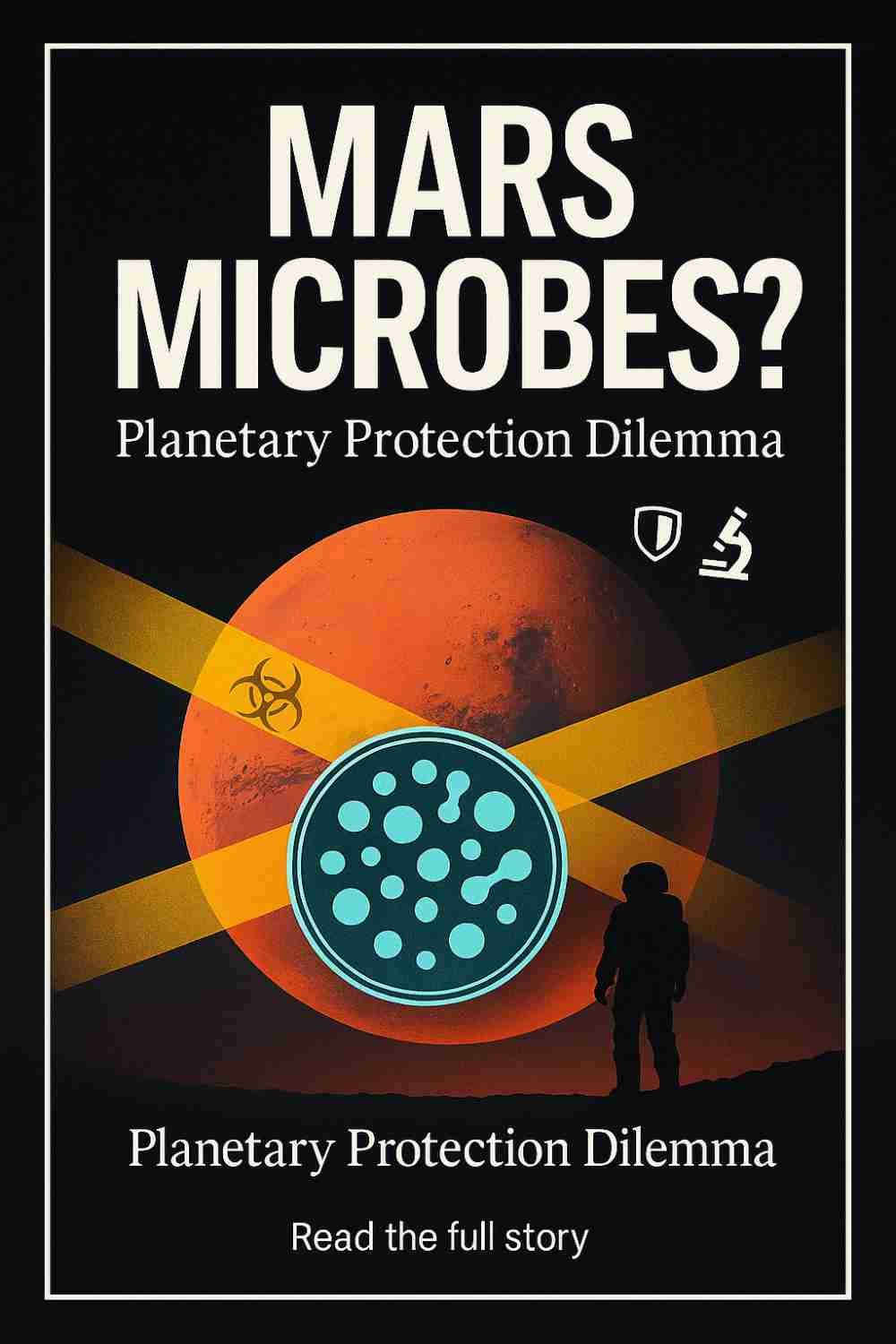What If Mars Already Hosts Microbes? Planetary Protection Dilemma
We’ve spent half a century treating Mars like a pristine crime scene. Gloves on. Tweezers out. Don’t smudge the evidence. But what if the “evidence” is alive—right now—clinging to salty grains in the regolith, hiding in the pores of basalt, or sleeping deep below the frost line? If Mars already hosts microbes, our red-planet playbook changes overnight. Exploration becomes bioethics. Engineering becomes epidemiology. And every wheel track is a decision with consequences.
🧬 This isn’t sci-fi—it’s policy in motion
Planetary protection isn’t a polite suggestion; it’s baked into international space law. The Outer Space Treaty (1967) obligates nations to avoid “harmful contamination” of celestial bodies and adverse changes to Earth from anything we bring back. That clause is the spine that holds the rest of the rules upright.
How do we turn that into practice? Through COSPAR—the international body that translates law into technical requirements. For Mars, COSPAR’s categories (III, IV, V) spell out how clean orbiters and landers must be, where they may operate, and what happens if we try to bring material home. “Special Regions” on Mars—places where terrestrial organisms could replicate—are treated like biological preserves: enter only with extreme caution and a mountain of documentation.
🧫 Two directions of risk (and why both matter)
Forward contamination is us dirtying Mars with our microbes. Backward contamination is Mars dirtying Earth with…whatever Mars has. That second one keeps lawyers, biologists, and risk analysts equally caffeinated. For Mars sample return, NASA classifies the mission under Category V (restricted Earth return), which demands top-tier containment and a dedicated receiving facility before so much as cracking a tube. This is “BSL-4 but for rocks,” with sterilization, quarantine, and redundant barriers standing between Martian material and Earth’s biosphere.
🔎 Could we already have hints?
Mars has teased us for decades. Viking’s Labeled Release experiment in the 1970s produced chemistry that looked suspiciously biological to some researchers, an interpretation still debated in the literature. Whether you agree or not, it taught us something humbling: Mars can imitate life’s signatures so convincingly that only careful, contamination-aware science can sort truth from trickery.
More recently, Curiosity has reported whiffs of methane—enticing if you like biology, explainable by geology if you prefer rocks—while other missions spot little to none, prompting new hypotheses about fleeting micro-plumes, surface chemistry, and instrument artifacts. The point isn’t that methane means life; it’s that Mars is a moving target, and “maybe” is enough to demand caution.
🧪 What changes the instant we confirm extant microbes?
Everything. You get three rapid-fire shifts:
Access: Regions with confirmed life become no-go for standard hardware. Only ultra-clean systems—possibly single-use, possibly sterilized at Viking-era levels—would be allowed. COSPAR already treats Special Regions with that posture. Expect those boundaries to expand overnight.
Sample return: Category V turns from paperwork to practice. No sample comes to Earth without a certified facility that can safely receive, test, and, if needed, permanently contain Mars material. This will slow timelines and raise costs—and that’s a feature, not a bug.
Human missions: Astronauts are brilliant explorers and terrible sterile payloads. Humans shed microbes, leak humidity, vent waste, and love to touch things. If Mars has native life, the architecture for habitats, suits, rovers, and waste streams must act like floating cleanrooms with teeth. NASA’s guidance already sketches this out; a confirmed detection would sharpen every line.
🚀 The human footprint problem
Boot prints are data and danger in equal measure. A crewed base on lifeless basalt is one thing; a base near a living ecosystem—no matter how microscopic—is another. You can’t tape a “Do Not Enter” sign over subsurface ice and call it protection.
What would a defensible plan look like?
Hard zoning. Declare biological parks around confirmed microbe sites. No crew, no routine robots. Only sterile, purpose-built instruments, and even then, sparingly.
Bioburden budgets. Treat every mission as a finite contamination allowance and spend it like cash. COSPAR’s numerical spore limits for Mars landers give us a baseline; human systems would need stricter, dynamic accounting.
Waste as a biosafety system. All human waste streams—air, water, solids—must be captured, sterilized, and monitored before release or recycling. “Closed loop” stops being a sustainability slogan and becomes a planetary promise.
🛰️ The sample-return curveball
Mars Sample Return (MSR) is the most ambitious—and politically fragile—planetary mission on the horizon. Plans have been reworked to cut cost, compress timelines, and even consider commercial heavy-lift options, but one thing won’t budge: if there’s any chance the tubes contain living material, Earth-entry and post-landing handling must be ultra-conservative. That means a certified facility, validated sterilization paths, and a testing strategy designed by people who lose sleep for a living.
Now imagine we confirm life before those tubes arrive. Expect the requirements to tighten, the facility to evolve, and the debate over “analyze there vs. analyze here” to get loud. Slow is smooth; smooth is safe.
🧗 Where the science gets messy (and fun)
Life detection does not look like TV. It’s a tangle of abiotic look-alikes, weird oxidation chemistry, and “we didn’t expect that” moments. Brines might come and go with the night, salts could protect organics in one layer and destroy them in another, and drilling a few centimeters deeper can flip your interpretation. This is why forward contamination matters: a single Earth microbe flourishing in the wrong crevice can spoof our instruments and rewrite Mars’ story in our handwriting. COSPAR’s Special Region posture exists exactly to prevent that.
⚖️ Ethics: do microbes get a vote?
You don’t have to ascribe moral rights to bacteria to recognize value. A second genesis—or even a cousinhood—would be the most consequential discovery in biology since biology began. That has stewardship written all over it. “But what about terraforming?” Great question. Terraforming is a century-scale engineering fantasy and a bioethical hornet’s nest if Mars is living. At minimum, discovery should freeze any “let’s warm the planet” ambitions until we understand what’s there and who thrives—or dies—if we change it.
🛡️ A practical playbook if Mars is alive
Here’s a sober, workable approach the community could rally around:
Draw a bright line around life. Catalog confirmed sites, designate them protected reserves, and publish their coordinates to every spacefaring agency and company. Violations carry real consequences.
Upgrade cleanliness—intelligently. For instruments entering protected zones, return to Viking-class sterilization where feasible. For everything else, enforce rigorous numerical bioburden caps and modern sterilization validation.
Adopt “clean before you come home.” Pre-entry sterilization options should be designed into MSR and future missions as off-ramps if tests raise flags. Category V already points that way; engineering needs to meet it.
Human missions on Mars ≠ humans in microbe country. Pick landing sites with low biological potential, enforce buffer zones, and treat EVA near sensitive terrain as extraordinary—not routine. NASA’s human PP guidelines are a start; they’ll need teeth.
Independent biosafety review. Establish an oversight board with authority across agencies and vendors. If someone is tempted to cut corners, this group says no—and it sticks.
Invest in “analyze there” capability. More sensitive life-detection instruments in ultra-clean packages reduce the need to import the unknown. Safer science, faster clarity.
📊 Key takeaways (fast, honest, non-negotiable)
✅ Law already applies. The Outer Space Treaty’s contamination clause is binding; COSPAR turns it into nuts-and-bolts requirements.
✅ Life finds you before you find it. One careless wheel rut can confuse a decade of data. Protect Special Regions by default.
✅ Category V is serious. If samples might be alive, containment and certified facilities aren’t optional; they’re the mission.
✅ Humans complicate everything. Amazing explorers, terrible sterilizers. Design habitats and EVAs like biosafety systems, not campsites.
✅ Patience is safety. Revised MSR plans will only succeed if biosafety drives the schedule—not the other way around.
🧭 So…do we press on or press pause?
Both. Press on with science in places where our presence won’t bulldoze the very thing we came to study. Press pause anywhere a Martian microbe could live or hitch a ride. That balance isn’t cowardice—it’s good fieldcraft. The prize here isn’t a flag on a hillside; it’s a clean answer to the oldest question we’ve ever asked: Are we alone?
Keep your curiosity sharp
If you like questions that bend your brain a little, you’ll love the Daily Bing Homepage Quiz—a quick, smart way to test what you know and learn what you don’t. For even more topics to explore, dive into the broader quiz hub at WeeklyQuiz and see what catches your eye.
